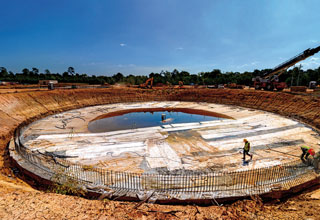Design Flexibility Reduces Sludge Digestion Costs at Conroe’s New Plant (Source: Water & Wastes Digest)
By Adam Kohout
Population increase and jurisdiction expansion drove the City of Conroe, Texas, to build a new Conroe Central Wastewater Treatment Plant (CCWWTP) to increase system treatment capacity. The owner contracted Lockwood, Andrews & Newnam, Inc. (LAN), a national planning, engineering and program management firm, to perform the design of the CCWWTP. LAN took the opportunity to provide added value by incorporating an advanced treatment into the design of the facility. This advanced treatment design, a two-stage process known as the A/B Process, would allow for beneficial anaerobic digestion of the two separate sludges produced. Design of the sludge processing system included blending of the two sludges, thickening, anaerobic digestion, dewatering, biogas capture, cleaning, storage, and use in power generation
To reduce capital expenditure, the A-Stage of the A/B Process was deferred to a later date. Consequently, the digestion design was altered to be aerobic, and all biogas equipment was deferred. The need for sludge blending was also deferred. These alterations to the sludge processing design allowed for a reduction in the capital cost of the initial construction. To maintain the possibility of utilizing the benefits of the A/B Process and anaerobic digestion in the future, the design alterations were made in such a way that treatment elements could easily be transitioned back to the original design. This provided the owner the option to expand the CCWWTP in the future, without abandoning structures installed in the initial construction.
CLICK HERE TO READ COMPLETE STORY

